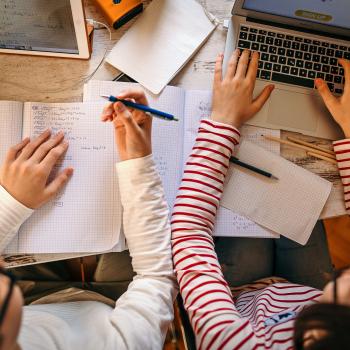E-pals Around the World

- Preview |
- Standards |
- Resources & Preparation |
- Instructional Plan |
- Related Resources |
- Comments
Overview
It is often difficult to motivate students to read and write. By integrating a letter-exchange program in the classroom, students become excited about literacy learning. This lesson helps you select e-pals for your students and develop real-life writing and learning experiences for them. Students learn the format of a friendly letter and the parts of an e-mail message. With careful selection of an e-pal group, students can also learn about other cultures, languages, and geographic areas that align with the curriculum in your school.
Featured Resources
Letter Generator: Your students will use this interactive tool to write final copies of their letters to their e-pals.
From Theory to Practice
- Pen-pal letters can offer many cross-curricular lessons and learning opportunities involving all subjects, including math, social studies, science, and technology.
- Pen-pal letters offer real-life hands-on experiences for students to use language. When writing their letters, students suddenly have an incentive to spell correctly, write in complete sentences, and use proper grammar and punctuation.
- Pen-pal letters offer many learning opportunities in social studies. By writing to a student from another part of the country or world, students can become aware of different cultures, religions, and languages.
- The Internet and other computer resources present many learning opportunities for students. E-mail is another pen-pal option.
Common Core Standards
This resource has been aligned to the Common Core State Standards for states in which they have been adopted. If a state does not appear in the drop-down, CCSS alignments are forthcoming.
State Standards
This lesson has been aligned to standards in the following states. If a state does not appear in the drop-down, standard alignments are not currently available for that state.
NCTE/IRA National Standards for the English Language Arts
- 1. Students read a wide range of print and nonprint texts to build an understanding of texts, of themselves, and of the cultures of the United States and the world; to acquire new information; to respond to the needs and demands of society and the workplace; and for personal fulfillment. Among these texts are fiction and nonfiction, classic and contemporary works.
- 4. Students adjust their use of spoken, written, and visual language (e.g., conventions, style, vocabulary) to communicate effectively with a variety of audiences and for different purposes.
- 5. Students employ a wide range of strategies as they write and use different writing process elements appropriately to communicate with different audiences for a variety of purposes.
- 8. Students use a variety of technological and information resources (e.g., libraries, databases, computer networks, video) to gather and synthesize information and to create and communicate knowledge.
- 12. Students use spoken, written, and visual language to accomplish their own purposes (e.g., for learning, enjoyment, persuasion, and the exchange of information).
Materials and Technology
Overhead projector and transparencies
Printouts
- Sample Letter (handout and transparency)
- Blank E-mail Message (handout and transparency)
Websites
Preparation
| 1. | Log on to the ePals Global Community website. While access to this site is free, you will need to provide some personal information (e.g., the name of your school and your e-mail address) to register your class. Begin a search for a class interested in participating in an e-mail exchange. |
| 2. | Complete preliminary communications with the teacher who responds to your request for an e-pal assignment. Pair each student in your class with an e-pal from the corresponding class—it is best to select a class with a similar number of students. Also, obtain the school's mailing address for sending letters. |
| 3. | Check with your school's privacy policy in regard to Internet and e-mail access. If needed, complete a parental permission form for each student to participate in an e-pal program. Your technology administrator should be able to assist you with this task. |
| 4. | Develop a communication schedule with the teacher you have paired with for the program. What are your expectations for message exchanges? Suggest and agree on a timeline for assignments, such as one written letter every two weeks and one e-mail message every week. Make sure the timeline is agreeable to both parties involved. It can be very frustrating for students to send messages and never receive any response. |
| 5. | Reserve class time in the computer lab for students to send their first e-mail message. This will enable you to address any problems that arise initially. After the first e-mail, develop a schedule for students to send future messages using the classroom computers. One suggestion is to place a calendar near the classroom computers with the names of the students written on each day to help adhere to a schedule. |
| 6. | Constant communication with the coordinating teacher is very important throughout the project. Once students get to know each other, you can coordinate topics for discussion or collaborative projects that fit in with your curriculum. Some examples include comparisons of cultures, geographic areas, language, collaborative writing activities, and book talks. |
| 7. | Write a sample friendly letter to your students inviting them to join this special project. As part of the letter, include an explanation for why they are participating in the letter exchange. You might also include information about the location of their e-pals, your expectations for their participation, and other pertinent information. This sample letter provides the format for a friendly letter and can be revised for your own purposes. Make an overhead transparency of this letter for classroom instruction. |
| 8. | Print a blank e-mail message from your computer using a print screen function. If you have a projector that connects to a computer, you can display the blank e-mail message directly onto an overhead screen. Make paper copies for each student to use as a worksheet and a transparency if you do not have the technology to project the e-mail from a computer screen. |
Student Objectives
Students will
- Be able to identify the parts and format of a friendly letter
- Write a friendly letter using the appropriate format and proper spelling, capitalization, punctuation, and grammar
- Be able to identify the parts of an e-mail message
- Write and send an e-mail message
- Communicate with an e-pal according to a specified timeline
Friendly Letter
Whole-group instruction
Distribute the friendly letter that you prepared for your students about the e-pal project and display the transparency on an overhead projector. Label the parts of the letter and have students do the same on their copy. Make sure that you identify the heading, salutation, body, closing, signature, and postscript.
Brainstorm what kind of information should be included in the students' first letter to their e-pals. Make a list of this information on the board for future reference. Suggested topics include information about school, family, sports, hobbies, etc.
Independent work
Have students write a rough draft of a letter to their e-pal using the sample letter or your letter as a model. They can select a topic from the list generated during the brainstorming session or choose a topic of their own.
Pair and share
When a rough draft is complete, pair students with a peer in the class for help with proofing, editing, and revising. During this activity, students should be looking at one letter at a time and checking to make sure that the format of the letter is correct. They should also be looking for spelling errors and proper sentence structure, punctuation, and grammar.
Independent work
Have students use the interactive Letter Generator to write a final copy of their letter. Remind students to print their letter and the instructions for addressing an envelope when they are finished. [Photocopy the students' letters prior to mailing them for assessment purposes.]
Whole-group instruction
Show students how to address an envelope appropriately, explaining the purpose and format of the return address and reviewing some of the standard postal abbreviations (e.g., P.O., state abbreviations, Ave). Also, demonstrate how to properly fold a letter and insert it into the envelope. Post the corresponding school's address on the board or another convenient location for students to use when addressing their envelopes.
Independent work
Invite students to address their own envelopes and prepare their letter for mailing. Collect letters to be mailed when students are finished.
E-mail Message
Whole-group instruction
Display an overhead of a blank e-mail message. Point out and explain each part of the message and model how each section is completed. Make sure to cover each section, including From, To, CC, BCC, Subject, and Body. Depending on the level of your students, you can also introduce attachments, priority settings, and text options (e.g., bold, italics, size, color). Explain how to use the Spellchecker and Send button. Remind students that they should use complete sentences and proper punctuation and grammar when writing an e-mail. Chat room abbreviations, codes, and symbols are not appropriate for the e-mail communications between students and their e-pals.
Pair and share
Pair students and have each student write an e-mail message to his or her partner for practice. Students should put the name of their partner in the subject line. This helps with distributing e-mail messages once they are sent and received. Messages should be sent to a central e-mail address (i.e., the teacher's address at school or an address that has been set up specifically for this lesson). Have students share their e-mail messages with their partner. Each pair should check that the e-mail message is completed correctly and has proper punctuation, spelling, and grammar.
Computer lab
Have students open a new e-mail message form and type a message to introduce themselves to their e-pal. Review what information should be included from the previous brainstorming activity. Once students have completed their message, have them print a copy and share it with you before sending. Printed copies of the e-mail can also be used for assessment purposes or you can have students "CC" a copy to your e-mail address. [Note: As e-mails and responses are received, print and distribute them to students.] Encourage students to reply to the messages that they receive within one week.
Extensions
This lesson can easily be extended into other curricular areas by focusing on the content of the e-mail exchanges and prompting discussions on various topics. Some suggested topics include:
- Social Studies: geography, cultural differences
- Science: climate, environmental issues, native vegetation and animals
- Math: metric versus imperial measurement system, pricing of goods and services
Student Assessment / Reflections
- Assess the student's friendly letters to make sure that they are written in the correct format. Also check to see if the student followed the specified timeline for sending letters.
- Access the student's e-mail messages to make sure that they are completed and sent properly. Also check to see if the student followed the specified timeline for writing and responding to messages from his or her e-pal.
- Check ongoing communications between each pair of e-pals
- Have students reflect on this lesson by using the interactive Letter Generator to write a letter to their parents telling them about their e-pal experience and the things they have learned from participating in this project.

Add new comment